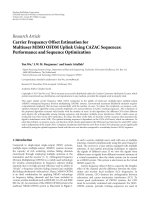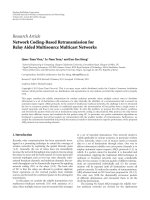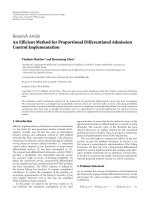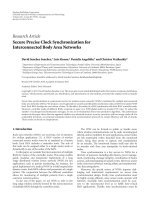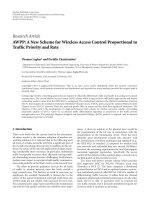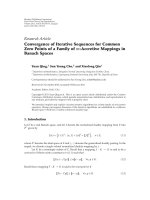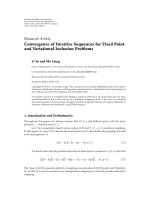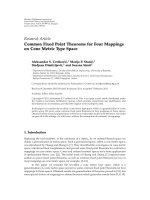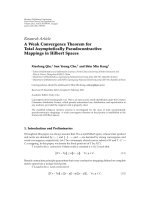Báo cáo hóa học: " Research Article Automatic Noise Gate Settings for Drum Recordings Containing Bleed from Secondary Sources" potx
Bạn đang xem bản rút gọn của tài liệu. Xem và tải ngay bản đầy đủ của tài liệu tại đây (1.44 MB, 9 trang )
Hindawi Publishing Corporation
EURASIP Journal on Advances in Signal Processing
Volume 2010, Article ID 465417, 9 pages
doi:10.1155/2010/465417
Research Article
Automatic Noise Gate Settings for Drum Recordings Containing
Bleed from Secondary Sources
Michael Terrell, Joshua D. Reiss, and Mark Sandler
The Centre for Digital Music, School of Electronic Enginee ring and Computer Science, Queen Mar y University of London,
London E14NS, UK
Correspondence should be addressed to Michael Terrell,
Received 1 March 2010; Revised 9 September 2010; Accepted 31 December 2010
Academic Editor: Augusto Sarti
Copyright © 2010 Michael Terrell et al. This is an open access article distributed under the Creative Commons Attribution License,
which permits unrestricted use, dist ribution, and reproduction in any medium, provided the original work is properly cited.
An algorithm is presented which automatically sets the attack, release, threshold, and hold parameters of a noise gate applied to
drum recordings which contain bleed from secondary sources. The gain parameter which controls the amount of attenuation
applied when the gate is closed is retained, to allow the user to control the strength of the gate. The gate settings are found by
minimising the artifacts introduced to the desirable component of the signal, whilst ensuring that the le vel of bleed is reduced by
a certain amount. The algorithm is tested on kick d rum recordings which contain bleed from hi-hats, snare drum, cymbals, and
tom toms.
1. Introduction
Dynamic audio effects apply a control gain to the input
signal. The gain applied is a nonlinear function of the level
of the input signal (or a secondary signal). Dynamic effects
are used to modify the amplitude envelope of a signal. They
either compress or expand the dynamic range of a signal. A
noise gate is an extreme expander. If the level of the signal
entering the gate is below the gate threshold, an attenuation
is applied. If the level of the signal is above the threshold the
signal passes through unattenuated. The attack and release
parameters control how quickly the gate opens and closes.
As the name suggests, noise gates are used to reduce the
level of noise in a signal. There are many audio applications,
for example, noise gates are used to remove, breathing from
vocal tracks, hum from distorted guitars, and bleed on drum
tracks, particularly snare and kick drum tracks. The use
of digital audio workstations (DAWs) for postproduction
means that it is quick and easy to manually remove s ome
sources of noise by silencing regions of an audio file.
However, it is very time consuming to manually remove
bleed from drum tr acks so noise gates are still heavily used.
The reader is referred to [1] for a comprehensive
review of digital audio effects (DAFx). In [2], a class of
sound transformations called adaptive digital audio effects
(A-DAFx) are defined. Adaptive effects extract features from
a signal and use them to derive control parameters for
sound transformations. Adaptive audio effec ts have existed
for many years. Dynamic effects are simple examples of A-
DAFx because the control gain applied is derived from the
level of the input signal. Features can be extracted from the
input signal, an external signal, or the output signal before
being mapped to control parameters. These are referred
to as autoadaptive, external-adaptive, and feedback-adaptive
respectively. Cross-adaptive effects use two or more inputs;
the features of which are used in combination to produce the
control parameters for the sound transfor m ation.
A-DAFx have been used for automatic mixing applica-
tions. Early work focused on audio for conferencing. An
adaptive threshold gate is presented in [3]. This is an external
adaptive effect. Ambient noise is picked up by a secondary
microphone from which the level is extracted. The level
of the noise is mapped to the threshold of a noise gate
which is applied to the primary microphone. In [4], a
direction sensitive gate is presented. This is a cross-adaptive
effect. Each microphone unit contains two microphones.
These face toward and away from the speaker. The level
of the signals entering the microphones is extracted and
2 EURASIP Journal on Advances in Signal Processing
compared to determine the direction of the signal. The
direction is mapped to an on/off switch which ensures that
the microphone is only ac tive if the sound source is in front
of it.
Recent automatic mixing work has turned toward audio
production. Perez-Gonzalez and Reiss [5–7]havepresented
A-DAFx for live audio production. A cross-adaptive effect
which does automatic panning is presented in [5]. The
automatic panner extracts spectral features from a number
of channels, each of which corresponds to a different
instrument. The spectral features are mapped to panning
controls, subject to predefined priority rules. The objective is
to separate spatially those instruments with similar frequency
content. The work in [6] is used to reduce spectral masking
of a target channel in a multichannel setup. This is a
cross-adaptive effect. It extracts spectral features from each
channel, and if a channel has a similar spectral content
to the predefined target channel an attenuation is applied.
Automatic fader control is demonstrated in [7]. This is
a cross-adaptive effect. It extracts the loudness from each
channel. Loudness is a perceptual feature, a function of
level and spectral content. The loudness of each channel
is compared to the average loudness of all channels and is
mapped to fader controls. This mapping seeks to make the
loudness of all channels equal.
In [7] the cross-adaptive effect is used to instantiate
changes to the fader controls which seek to produce a
predefined outcome: equal loudness in all channels. This can
be viewed as a form of real-time optimization. There are a
few examples of audio effect parameter automation, where
the optimization is performed offline. Whilst these do not
fit neatly into the A-DAFx structure, they still incorporate
feature extraction and feature mapping. In [8], a method is
presented which allows perceptual changes in equalization
to be made to an audio signal. An example requirement is
to make the signal sound brighter. This is a cross-adaptive
effect. The spectral features of the input signal are extracted
and are compared with a database of previously examined
signals, to which perceptually classified equalization changes
have been made. A nearest neighbour optimization is
used to map the similarity in spectral features to relevant
equalization settings. In [9], a method is presented which
automatically sets the release and threshold of a noise gate
applied to drum recordings. This work is expanded here.
This is an autoadaptive effect. The distortion to the target
signal and the residual noise are extracted from the input
signal. An objective function is defined which is a weighted
combination of these two features. The objective function
is minimised subject to weighting parameter, mapping the
features to the release and threshold.
Automatic audio effects for musical applications gener-
ally have a user input which takes subjective considerations
into account. For example, [5] has a global panning width
control and [6] has a maximum attenuation control. The
panning values output by the automatic panner are scaled
between the center, and the user-defined global panning
width. The maximum attenuation control defines the maxi-
mum gain reduction that can be applied to channels in order
to reduce masking with the target channel. If the use of an
audio effec t cannot be defined in a purely objective way, it is
advisable to decouple subjective and objective elements when
attempting to automate it. In the case of a noise gate this
distinction can be made clearly. The objective is to reduce
the amount of noise, so the gate should attenuate the signal
when noise is prevalent and should not attenuate when the
wanted signal is prevalent. The subjective element is the level
of attenuation that should be applied.
2. Method
2.1. Noise Gates in Drum Recordings. A noise gate has five
main parameters: threshold (T), attack (A), release (R),
hold (H), and gain (G). Threshold and gain are measured
in decibels, and attack, release, and hold are measured in
seconds. The threshold is the level above which the signal
will open the gate and below which it will not. The gain is
the attenuation applied to the signal when the gate is closed.
The attack is a time constant representing the speed at which
the gate opens. The release is a time constant representing the
speed at which the gate closes. The hold parameter defines
the minimum time for which the gate must remain open. It
prevents the gate from switching between states too quickly
which can cause modulation artifacts.
A typical drum kit comprises kick drum, snare, hi-
hats, cymbals, and any number of tom toms. An example
microphone setup will include a kick drum microphone, a
snare microphone (possibly two), a microphone for each
tom tom, and a set of stereo-overheads to capture a natural
mix of the entire kit. In some instances a hi-hat microphone
will also be used. When mixing the recording, the overheads
will be used as a starting point. The signals from the other
microphones are mixed into this to provide emphasis on
the main rhythmic components, that is, the kick, snare, and
tom toms. Processing is applied to these signals to obtain the
desired sound. Compression is invariably used on kick drum
recordings. A compressor raises the level of low amplitude
regions in the signal, relative to high amplitude regions which
has the affect of amplifying the bleed. Noise gates are used to
reduce (or remove) bleed from the signal before processing is
applied.
Figure 1(a) shows an example kick drum recording
containing bleed from secondary sources. Figure 1(b) shows
the amplitude envelope of the kick drum contained within
the recording, and Figures 1(c) and 1(d) show the amplitude
envelope of bleed contained within the signal. The large and
small spikes up to 1.875 seconds in Figure 1(c) are snare hits
and the final two large spikes are tom-tom hits. Figure 1(d)
has reduced limits on the y-axis. This figure shows the
cymbal hit at 0 seconds, a nd hi-hat hits, for example, at
1.625 seconds. The amplitude of these parts of the bleed is
very low and will have minimal affect on the gate settings.
Components of the bleed signal which coincide with the
kick drum cannot be removed by the gate (because it is
opened by the kick drum). The snare hits coincide with
the decay phase of the kick drum hits and so will have the
biggest impact on the noise gate time constants. If the release
time is short, the gate will be tightly closed before the snare
hit, but the natural decay of the kick drum will be choked.
EURASIP Journal on Advances in Signal Processing 3
0 0.5 1 1.5 2
−1
−0.5
0
0.5
1
Time (s)
Amplitude
(a)
0 0.5 1 1.5 2
Time (s)
Amplitude
0
0.2
0.4
0.6
0.8
1
(b)
0 0.5 1 1.5 2
Time (s)
Amplitude
0
0.1
0.2
0.3
0.4
0.5
(c)
0 0.5 1 1.5 2
Time (s)
Amplitude
0
0.005
0.01
0.015
0.02
(d)
Figure 1: An example kick drum recording, (a) is a noisy microphone signal which includes kick drum and bleed, (b) shows the amplitude
envelope of the kick drum contained within the noisy signal, and (c) and (d) show the amplitude envelope of the bleed contained within the
noisy signal. Part (d) has reduced limits on the y-axis to show cymbals and hi-hats in the bleed signal.
If the release time is long the gate will remain partially open,
and the snare hit will be audible to some extent, but the
kick drum hit will be allowed to decay more naturally. If
the threshold is below the peak amplitude of any part of the
bleed signal, then the bleed will open the gate and will be
audible. It is necessary to st rike a balance between reducing
the level of bleed and minimising distortion of the kick
drum.
2.2. Audio Files, Artifacts, and Noise Reduction. Audio files
representatives of a kick drum recording containing bleed
from hi-hats, snare drum, cymbal, and tom toms are
investigated. The audio is generated using the commercial
software BFD2 from FXpansion. In this software the samples
for each drum have been recorded with all microphones
active so natur al bleed is available. Test audio files are made
by soloing the output of the kick drum microphone. Audio
files are sequenced by the author. The kick drum signal which
contains bleed is referred to as the noisy signal, y
n
[n]. This is
a combination of the clean kick drum signal y
k
[n] and the
bleed signal y
b
[n],
y
n
[
n
]
= y
k
[
n
]
+ y
b
[
n
]
,
(1)
where [n] is the sample index. [n] will be dropped from this
point onward for clarity. Time domain vectors are identified
by lowercase, bold, typeface. Passing a signal through the
noise gate will generate a gate function, g. This vector
contains the gain to be applied to each sample of the input
signal. An example gate function is plotted in Figure 1(a).
The gate function will generate distortion artifacts in the kick
drum signal, D
A
,
D
A
=
1 − g
T
. ∗ y
k
2
y
k
2
,
(2)
and will reduce the bleed sig nal to a residual level, D
B
,
D
B
=
g
T
. ∗ y
b
2
y
b
2
,
(3)
4 EURASIP Journal on Advances in Signal Processing
where .
∗ is the elementwise, vector multiplication operator.
The signal to artifact ratio (SAR) and the reduction in the
bleed level (δ
bleed
)aregivenby
SAR
= 20log
10
D
−1
A
,
δ
bleed
= 20log
10
(
D
B
)
.
(4)
In [9] it is proposed that optimal noise gate settings should
be found by minimising an objective function which is a
weighted combination of the distortion artifacts D
A
and
the noise reduction D
N
. The weighting parameter is then
used to control the strength of the gate. The release and
threshold are parameters in the objective function, but
attack, gain, and hold are fixed. The attack is set to the
minimum time of 1 ms, the gain to
−∞ dB, and the hold
to a value that prevents distortion. A usable automatic
gate requires these parameters to be included, in particular
the gain setting, which if fixed at
−∞ dB will choke the
kick drum sound severely. The implementation presented
in this paper also includes the attack time and hold time
as parameters in the objective function. The gain is used
in place of the weighting parameter to control the strength
of the gate. Rather than minimising an objective function
which contains the distortion art ifacts and the residual noise,
the distortion artifac ts are minimised (SAR is maximised),
subject to the reduction in the bleed being g reater than some
threshold.
2.3. Approximating Distortion Artifacts and Noise Reduction.
The distor tion artifacts and noise reduction cannot be
evaluated without separating the kick and bleed components
of the signal. The human auditory system can do this
instinctively. A human user will have prior knowledge of
what the clean signal sounds like, that is, the user will know
that the clean signal is a kick drum. This is replicated when
automating the noise gate by inputting a single, clean, kick
drum hit to the algorithm. In practice this could be obtained
during a sound check, or could be taken from a database of
kick drum samples.
The noisy signal is split into windows of quaver length.
Each window is attributed to kick or bleed. The divisions
within the noisy signal are made based on note onsets. Onsets
are identified manually, but it is assumed that they could be
identified exactly using an onset detection algorithm. The
work in [10] is a benchmark paper on onset detection, and
[11] contains a summary of drum transcription and source
separation techniques. The spectral power of each window
of the noisy signal is correlated with the spectral power of a
region of the clean kick drum signal of equal length. If the
correlation is above a predefined threshold, it is attributed to
kick drum. The correlation is calculated as the scalar product
of the normalised spectral powers. X
i
is the spectral power of
window i of the noisy signal, and X
c
is the spectral power of
the clean kick drum signal. The correlation is given by
c
i
=
X
i
X
i
T
·
X
c
X
c
,
(5)
where c
i
is the correlation of the spectral powers of window
i of the noisy signal with the clean kick drum signal.
Windows of the noisy signal with a correlation greater than
the threshold of 0.95 are assigned to kick drum. All other
windows are assigned to bleed. An approximation of the
clean signal is made by aligning a copy of the clean kick drum
hit with the start of each window assigned to kick drum.
This forms the synthesized clean signal y
z
, which is used in
place of y
k
in (2). The bleed is approximated by silencing
all windows in the noisy signal which are attributed to the
kick drum.
Figure 2 shows how the approximations to the kick
and bleed components in the noisy signal are obtained.
Figure 2(a) shows the noisy signal. It has been quantized
with an eighth note quantization grid and windows are
based on this spacing. Figure 2(d) of this figure shows the
correlations between the spectral power of each window in
the noisy signal with the spectral power of the clean kick
drum hit. Marked on this figure is the correlation threshold
of 0.95. All windows which contain a kick drum hit have a
correlation above this threshold. Figures 2(b) and 2(c) show
the synthesized kick drum signal, y
z
, and the approximate
bleed signal, y
b
, respectively. The dotted lines on Figures 2(a)
and 2(c) show the gate function g, which is the gain applied
by the gate as the noisy signal passes through it. The dotted
line on Figure 1(b) shows the function (1
−g). These are used
to estimate the distortion artifacts and the residual noise as
defined in (2)and(3).
2.4. The Noise Gate Optimization Algorithm. Common prac-
tice when using a noise gate to reduce bleed in drum
tracks is to first set the gain to
−∞ dB. The threshold is
then set as low as possible to allow the maximum amount
of kick drum to pass through without allowing the gate
to be opened by the bleed signal. The release is set as
slow as possible whilst ensuring that the gate is closed
before the onset of any bleed notes. For very fast tempos
this may not be possible without introducing significant
artifacts, in which case some bleed notes which occur close
to the kick drum hit may be allowed to pass through. The
implications of this in the automatic implementation will be
discussed later. It is assumed that the gate must be closed
for all bleed onsets. The attack is set to the fastest value
which does not introduce any distortion artifacts. The hold
time is continually adjusted to remove modulation artifacts
caused by rapid opening and closing of the gate. D uring an
interonset interval assigned to kick drum, the gate should
go through one attack phase and one release phase only.
The hold parameter should be as low as possible whilst
maintaining this requirement. If it is too long it can affect
the release phase of the gate. Once all other parameters
have been set, the gain is adjusted subjectively to the desired
level.
Figure 3 is a flowchart of the algorithm. The inputs on
the left are constraints enforced at each stage. The inputs
on the right are the parameter values at each stage. The
signal is split into regions which contain kick drum and
regions w hich contain bleed, as discussed in Section 2.3.
An initial estimate of the threshold is found by maximising
the SAR, subject to the constraint that the bleed level is
reduced by at least 60 dB. This is identified by the parameter
EURASIP Journal on Advances in Signal Processing 5
0 0.2 0.4 0.6 0.8 1 1.2 1.4 1.6 1.8 2
−1
0
1
−1
0
1
Am
pli
tud
e
Am
pli
tud
e
Am
pli
tud
e
0 0.2 0.4 0.6 0.8 1 1.2 1.4 1.6 1.8 2
0 0.2 0.4 0.6 0.8 1 1.2 1.4 1.6 1.8 2
Time (s)
−0.1
0
0.1
(a)
(b)
(c)
12345678910111213141516
0
0.1
0.2
0.3
0.4
0.5
0.6
0.7
0.8
0.9
1
Window index (i)
(d)
Correlation (c
i
)
Figure 2: Approximations to the kick drum and bleed signals, (a) contains the noisy signal y
n
, (b) contains the synthesized clean kick drum
signal y
z
, (c) contains the component of the signal attributed to bleed y
b
, and (d) shows the correlation of the spectral power of each window
with the spectral power of the clean kick drum signal. The correlation threshold is identified by the dotted line.
δ
bleed
, which is the minimum change in the bleed level
after gating. The attack, release, and hold are set to their
minimum values during the initial threshold estimate and
the g a in is set for ful l signal attenuation (G
= 0ona
linear scale). This ensures that the threshold is set to the
lowest feasible value. The minimum hold time is found
which permits only one attack phase and one release phase
for each kick drum window. These constraints are identified
by parameters N
attack
and N
release
which correspond to the
permitted number of attack and release phases, respectively.
The other gate inputs are the minimum values of attack
and release and the initial threshold estimate. The threshold
estimate is required because the minimum hold time can
vary significantly with threshold. The threshold is then
recalculated using the updated hold parameter. Finally the
attack and release are found by maximising the SAR, subject
to the bleed reduction. Steepest descent gradient methods are
used to minimise functions at each stage.
Breaking the algorithm into stages rather than defining a
single objective function which contains all parameters has
a significant advantage in this kind of optimization scheme.
The major problems when using a single objective function
are discontinuous regions in the solution space and regions
of the solution space which have zero sensitivity with respect
to small changes to the parameters. This is the case for all
parameters when the threshold is close to zero (at which
point the signal level is always above the threshold). By
optimising each parameter in turn, and ensuring that the
start point lies within a sensitive, continuous region at each
stage, this problem is overcome. Alternative optimization
methods which do not rely on gradient information could
potentially be used.
3. Results
The algorithm is tested using a simple drum beat. The tempo
of the beat is 120 bpm, the time signature is 4/4, and the
kick hits lie on a 1/8 note quantization grid. There are
some 1/16 note snare drum hits, but none of these occur
immediately after a kick drum hit. This ensures that each kick
drum window has a length of 1/8 note. The required bleed
reduction is set to δ
bleed
=−60 dB, and the g ain of the noise
gate is set to
−∞ dB, that is, full attenuation. Figures 4(a) and
4(b) show the signal before and after gating, respectively. The
gate function is plotted with a dashed line. It can be seen that
the kick drum decay phase of the gated kick drum has been
shortened, so that the signal level is approximately zero at the
beginning of the region assigned to bleed, which occurs at
0.5 s. A user would now be free to adjust the g ain parameter
with the automated threshold, attack, release, and hold to
change the strength of the gate.
The automatic noise gate algorithm is now investigated
for a range of required bleed reductions, and for a range of
noisy signals which contained different strengths of bleed.
The strength of the bleed is measured relative to the test
case described above, and includes bleed strengths of +0 dB,
+2dB,+4dB, and+6dB.Figures 5(a)–5(d) contain plots of
the threshold, release, hold, and SAR, respectively. The attack
has not been plotted b ecause in all cases the algorithm set it
to the minimum value of 1 ms.
Initial discussions are focused on the signal with a relative
bleed strength of +0 dB. Figure 5(a) shows that the threshold
has a stepped profile, and that it decreases as the required
bleed reduction is decreased. Ta ble 1 shows the peak levels
extracted from each region of the noisy signal attributed
to bleed. The overall peak level is
−28 dB, which occurs in
6 EURASIP Journal on Advances in Signal Processing
Split audio into kick
and bleed
Estimate T
T, H
H
Calculate H
Calculate T
Calculate A, R
G
= 0
G
= 0
G
= 0
G
= 0
A
min
, R
min
A
min
, R
min
A
min
, R
min
, H
min
T = T
est
δ
bleed
=−60 dB
δ
bleed
=−60 dB
δ
bleed
=−60 dB
N
attack
= 1
N
release
= 1
Maximise(SAR)
Maximise(SAR)
Maximise(SAR)
Minimise(H)
Figure 3: Automatic noise gate flow chart.
the final section and is due to the tom tom hits. Inspection
of Figure 5(a) shows that the threshold is above this for
δ
bleed
< −10 dB, and so the bleed signal will not open the
gate. Large reductions in bleed, for example, δ
bleed
=−60 dB,
result in thresholds which are higher than the peak level
of the bleed by around 3 dB. This headroom is required to
ensure that the gate has sufficient time to close during the
release phase (which in calculating the threshold is set to
the minimum value of 10 ms). As the required reduction in
bleed becomes smaller, the gate does not need to be closed so
tightly by the end of the release phase, which permits a lower
threshold. The threshold follows a stepped profile because
the bleed reduction is highly sensitive to small changes in
the threshold. The threshold is set using the predetermined
hold time and minimum attack and release times, as shown
in Figure 3. Using these parameter values, a change in the
threshold from
−25.89 dB, to −22.56 dB results in a change
in δ
bleed
from −22.5 dB to −56.4 dB. With the tolerance used,
there are no intermediate threshold values that will give a
bleed reduction between
−22.5 dB and −56.4 dB. When the
strength of the bleed is increased, a similar trend can be seen,
but the difference between the threshold and the peak level
of the bleed (shown in Table 1) gets progressively smaller.
This is because with a higher strength of bleed, the absolute
reduction in bleed to produce the same relative change is
smaller, and the gate does not need to be closed so tightly
by the end of the release phase.
For a fixed threshold the release time gradually increases
as the required bleed reduction decreases. This is expected
because the gate does not need to be closed so tightly by
the start of the bleed window. Each step drop in threshold
causes a sudden shortening of the time between the start of
the release phase and the start of the following bleed window
and so a step drop in release time is needed to produce the
required bleed reduction.
Table 1: Peak signal level in the bleed regions identified by t
1
and t
2
for a range of relative bleed strengths.
t
1
t
2
0dB +2dB +4dB +6dB
0.5 1 −29.1 −26.3 −25.6 −24.9
1.5 2.25
−29.1 −28.7 −28.2 −27.6
2.5 3
−29.3 −28.9 −28.4 −29.7
3.5 4
−28.0 −26.5 −24.5 −22.7
The hold time g ives what appears to be the most
unintuitive results. For signals with relative bleed strengths
of +0 dB, +2 dB, and +4 dB, the hold time remains roughly
constant at around 40 ms. The signal which has a bleed
strength of +6 dB has a far lower hold time when the required
bleed reduction is large, and shows a sudden increase in
hold time when δ
bleed
> −20 dB. The value of the hold
time will depend on the degree to which the envelope of the
kick drum signal is fluctuating about the threshold. If there
are substantial fluctuations a longer hold time is required.
The hold time is determined using the initial estimate of
the threshold. Signals with different relative bleed strengths
have different initial threshold estimates. Evidently for the
signal with a bleed strength of +6 dB, there are minimal
fluctuations in the envelope of the kick drum signal about the
initial threshold estimate when the required bleed reduction
is large. When the required bleed reduction is decreased,
the initial threshold estimate is lower, and there are more
fluctuations in the envelope of the kick drum signal about
it. A longer hold time is therefore needed.
The SAR generally increases as the required reduction
in bleed decreases. This is expected. A gentler gate causes
less distortion in to kick drum signal. There are a few
anomalous points where a decrease in the required bleed
reduction is accompanied by an decrease in the SAR.
EURASIP Journal on Advances in Signal Processing 7
01234
−0.5
0
0.5
Amplitude
Time (s)
(a)
01234
−0.5
0
0.5
Amplitude
Time (s)
(b)
0 0.2 0.4 0.6 0.8 1
−0.2
−0.1
0
0.1
0.2
Time (s)
Amplitude
(c)
0 0.2 0.4 0.6 0.8 1
−0.2
−0.1
0
0.1
0.2
Time (s)
Amplitude
(d)
Figure 4: Kick drum recording before and after gating, (a) before gating, and (b) after gating, with δ
bleed
=−60 dB.
These points coincide with step reductions in the threshold
and release. It is suggested that in these transitional points
a smoother change in the release and threshold may be
required. This cannot be achieved with the algorithm in
its current form because the threshold and release time are
evaluated independently. It may be possible to include an
additional, final stage which optimizes all of the parameters
together.
4. Discussion
In designing the algorithm, manual use of a noise gate has
been taken into account. It is the opinion of the author that
by replicating the human thought process, the automated
results should b etter approximate those obtained by a human
user. Although formal evaluation has not been undertaken,
informal testing has shown this to be the case.
The algorithm has been designed so that it is independent
of the specific noise ga te implementation. It would be
easier to develop an algorithm if hidden aspect s of the
implementation, such as the transient filter properties, and
the level detector, were known, but this would limit the use of
the algorithm to a specific noise gate. This approach also ties
in with the concept of replicating human operation because
the parameters are set based only on the input and output of
the gate and so much like with a human user, decisions are
based purely on changes to the properties of the signal. It is
the opinion of the author that this black box approach has
most potential when considering commercial developments
in the automation of any audio effect, as it allows the
automation algorithm to be developed independently of the
effect implementation (so long as the same parameters are
available).
The algorithm presented divides the signal into a number
of intervals based on the position of onsets. Problems will
arise with drum recordings at high tempos and with high
resolution quantization grids. In these cases it is likely that
the kick drum regions will be very short, resulting in a
choked kick drum sound after gating. A human operator
would adjust the release to allow some bleed onsets which
are close to the kick drum hit to pass through. This should be
incorporated into the automatic gating algorithm. This could
be done by defining a minimum kick drum window length,
based on the amplitude envelope of the clean kick drum hit.
It is interesting to consider how the automatic noise gate
presented in this paper fits into the A-DAFx framework.
Most A-DAFx have a small analysis frame and update control
parameters continuously, more or less in real time. This is
particularly the case with established auto-adapative effects
such as compressors. The algorithm presented here uses an
audio segment of around 8 seconds, and takes 5–10 seconds
to form and minimise the objective function. Despite this
8 EURASIP Journal on Advances in Signal Processing
−60 −50 −40 −30 −20 −10
−28
−27
−26
−25
−24
−23
−22
Threshold (dB)
δ
bleed
(dB)
(a)
−60 −50 −40 −30 −20 −10
0
50
100
150
Release (ms)
δ
bleed
(dB)
(b)
−60 −50 −40 −30 −20 −10
10
15
20
25
30
35
40
45
Hold (ms)
δ
bleed
(dB)
(c)
−60 −50 −40 −30 −20 −10
14
15
16
17
18
19
20
21
SAR (dB)
δ
bleed
(dB)
(d)
Figure 5: Noise gate parameter values after optimization, plotted against the required reduction in bleed (δ
bleed
as defined in Figure 3). Part
(a) shows threshold, (b) shows release time, (c) shows hold time and (d) shows SAR. Results are plotted for a number of relative bleed
strengths identified by,
:+0dB,:+2dB,∗:+4dB,×:+6dB.
lengthy time frame the algorithm could still be implemented
within the A-DAFx framework. Large and sudden changes
to noise gate parameters are undesirable, so an accumulative
learning approach could be used as in [7].
Subjective evaluation has not yet been performed for
this work. It would be useful to compare the values of
the gate parameters output by the algorithm to those of
an experienced engineer. This could be used to determine
suitable reductions in SNR to be used in the algorithm, which
may or may not be based on properties of the input signal.
5. Conclusions
An algorithm has been presented which automatically sets
the threshold, release, attack, and hold parameters of a noise
gate used on a kick drum recording that contains bleed from
secondary sources. The parameters identified cause minimal
distortion to the kick signal, whilst enforcing a predefined
reduction in the level of the bleed signal. The gain parameter
is not set automatically and is used to manually control
the strength of the gate. The algorithm has been developed
independently from the noise gate implementation, and
through consideration of the process followed by a human
user. It has been tested for signals with varying levels of bleed,
and varying amounts of bleed reduction. The gate setting s
found are intuitively correct, although as yet no subjective
evaluation has been undertaken to compare them to expert
users.
Acknowledgment
The authors would like to thank the EPSRC for funding this
research.
References
[1] U. Zolzer, Digital Audio Effects, John Wiley & Sons, New York,
NY, USA, 2002.
[2] V. Verfaille, U. Zolzer, and D. Arfib, “Adaptive digital audio
effects (A-DAFx): a new class of sound transformations,” IEEE
Transactions on Audio, Speech and Language Processing, vol. 14,
no. 5, pp. 1817–1831, 2006.
EURASIP Journal on Advances in Signal Processing 9
[3] D. Dugan, “Automatic microphone mixing,” in Proceedings of
the AES 51st International Convention, 1975.
[4] S. Julstrom and T. Tichy, “Direction-sensitive gating: a new
approach to automatic mixing,” in Proceedings of the AES 73rd
International Convention, 1976.
[5] E. Perez-Gonzalez and J. Reiss, “Automatic mixing: live down-
mixing stereo panner,” in Proceedings of the 10th International
Conference on Digital Audio Effects (DAFX ’07), 2007.
[6] E. Perez-Gonzalez and J. Reiss, “Improved control for selective
minimization of masking using inter-channel dependancy
effects,” in Proceedings of the 11th International Conference on
Dig ital Audio Effects (DAFX ’08), 2008.
[7] E. Perez-Gonzalez and J. Reiss, “Automatic gain and fader
control for live mixing,” in Proceedings of the IEEE Workshop
on Applications of Signal Processing to Audio and Acoustics
(WASPAA ’09), pp. 1–4, October 2009.
[8] D. Reed, “Perceptual assistant to do sound equalization,” in
Proceedings of the International Conference on Intelligent User
Interfaces (IUI ’00), pp. 212–218, January 2000.
[9] M. Terrell and J. Reiss, “Automatic noise gate settings for
multitrack drum recordings,” in Proceedings of the 12th
International Conference on Digital Audio Effects (DAFX ’09),
September 2009.
[10] A. Klapuri, “Sound onset detection by appluing psychoa-
coustic knowledge,” in Proceedings of the IEEE International
Conference on Acoustics, Speech and Signal Processing (ICASSP
’99), pp. 115–118, Phoenix, Ariz, USA, 1999.
[11] D. FitzGerald, Automatic drum transcript ion and source sepa-
ration, Ph.D. thesis, Dublin Institute of Technology, 2004.

